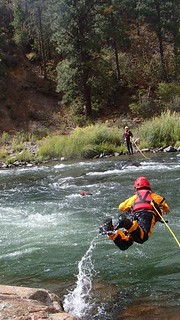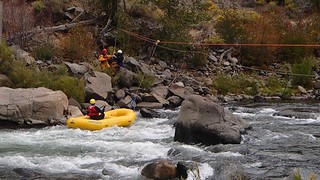Advanced Swiftwater Rescue
2013-10-10
I took another rescue class. This is the third class in a set of 3. TRR, SRT-1 and now SRT-A. TRR is Technical Rope Rescue. SRT-1 is swiftwater rescue technician level 1. And this class was the Swifwater Rescue Technician Advanced class. You can see my previous two posts for the last two classes:
- http://www.blog.smalladventures.net/2013/05/technical-ropes-rescue-technician-level.html
- http://www.blog.smalladventures.net/2013/08/swiftwater-rescue-technician-course.html .

Unlike SRT-1 I don't think everyone needs to take this course. This class is intended really only for rescuers. While it's awesome to know more and I wouldn't discourage anyone, it's just not necessary for most people to have these skills. I took the series mostly out of curiousity and interest, but also so I could bring back some of the knowledge to my team CalESAR (which doesn't do swiftwater rescue), and lastly to rack up a few cool certifications that might help me get neat jobs. The end result is that I'm now certified to be in the water for complex rescues, such as those in class 3 rapids. So that's kindof cool.
Day 1
This was a 3 day class. We started by practicing swimming rapids and moving around in the river. I actually picked up a lot more about how water behaves. I was quite surprised to find that I could swim up eddies only a couple of feet across... pretty cool! Once again It's driven home that while brute force helps, it's rarely the best answer in rescue.
Here's a cool action shot of a class-mate. I believe this is while practising moving across a river.

We also did a few scenerios in the afternoon involving relatively simple rescues rapidfire. We had a few interesting occurances. I yet again learned that being IC is hard. I was trying to do the right thing and not get into the water much, but our class was only 6 people. We couldn't see the victim. I sent 3 to investigate and kept 3 as backups to see what happened. Well... basically the 3 dove into trying to rescue them and they had a very hard time calling back to shore for resources. In the end, I should've gone out to the island given the limited people available... oops! Lesson learned.
Later on in another scenerio. I ended up doing a live-bait rescue in some relatively heavy rapids, that was pretty fun. We'd tried to cross a rope but my first throw failed. IC at the time suggested a live-bait and asked if I could do the swim. It was on the edge for what I could do reliably (not that dangerous, just hard to actually get where I needed to be), but it worked... yay!
In the process of course we practiced throwbagging, live-bait rescue, swimming rapids, lassoing patients, and simple/fast river-crossing techniques (say, a quick rope across the river at an angle that people ride on caribeaners).
Day 2
I may have the order of events wrong, but I'm having trouble remembering for sure. In the morning we reviewed knots and the like, and a bit before lunch we rigged a highline tyrolean as a way to control a boat in the river. In the photo we were pretending the river was too wide to throw across, so we were using a combination of live-bait (me) and someone on the other side throwing to safely cross the rope farther than the person could throw.
The highline lets you get point accurate in the river on a platform, making the rescue a lot more static which is always good. It's a LOT of setup though, so no good if the patient isn't "stable" (in swiftwater this means head above water). It took us about an hour total to get set up, about 30 minutes of actual rigging after 30 minutes of discussion and gear allotment. The picture at the top is actually of me as we're crossing the highline. To get it across we used throwbags.

I was the first in the boat and quickly found that while it looks like the rope would decide where you are in the river, it's not that simple. The rope only does anything when taut. The thing to realize is not all of the water in the river is going downstream, when in an eddy nothing is pushing the boat downstream and the rope goes slack. So while this rigging helps enormously with controlling the boat and holding it in place in rapids, it has to be augmented by paddling and an understanding of what's going on in the river to make it work.
We also played on riverboards a bit, which is a great way to help understand the river, and a useful rescue tool as well.

That evening we had a night search planned. It was snowing on us by this point. And one group managed to lock themselves out of their car due to a "feature" where it sometimes decides to lock itself. So, we helped them break into their car again (hooray for carrying lots of tools in the truck) and everyone scooted off to find themselves dinner.

I realized as I warmed up during the drive that I had entered cold stupid. That is, I wasn't thinking very straight anymore due to being cold. I missed an easy toss earlier that day due to cold hands, and now it was catching up to me. I'm really glad I had a drysuit. Eventually I found a place to eat and stuffed my face as fast as I could, I was starving presumably from burning calories to stay warm and swim in rapids. Then I grabbed a cup of hot cocoa at starbucks and chilled out for a bit. I felt a lot better by the time I drove to the site for the night search.
The night search was on a calm piece of river. Our instructor Zach, realizing it was cold, restricted the IC to only using those of us with drysuits (2 people) as water rescuers, the rest had to stay on the bank. The bank rescuers actually found the victim, but since he was right next to the water decided to hand off medical to us and they ran up and started rigging for a low-angle extraction. After a lot of huffing a puffing and of course some mistakes we got the guy out safe, and no-one got too cold.
Day 3
On the 3'rd day we did no water at all. Instead after some administrative stuff we went to a different site and rigged a highline with a midpoint drop for actually lowering people. This highline being fairly sloped could also be properly termed an "offset" line.

Note the control line running from the highline down to the rescuer in the photo. That's the midpoint drop. If you look at the photos from my TRR class we didn't do the midpoint drop, instead we adjusted the tension of the highline to lower and raise the rescuer.

That technique works well in some situations, but you can see here the sides of the canyon are too steep to slack the highline, it would rub on the rocks.
Below is a photo of me operating the control line. There's also a "tag" line on the top side of the highline used to control where the carriage is on the highline. That is, the tag-line controls left-right, and the control-line controls up-down.

This was a pretty interesting class. I didn't have a lot of expectations going into it, but I definitely learned a lot and I'm really glad I took it. I feel a lot more confident about my understanding of more complex rigging and water rescues both. That said, if you aren't into Rescue this is probably not the place to spend your time and money.
Camping
As an interesting side-note I discovered that campgrounds in Tahoe in the off season are essentially free. They don't have Iron Rangers (places to just drop your money) and you are expected to pay a campground host who will stop by your site. Well, in the off season there is no host, so no way to pay for your site even if you wanted to. As a result I boondocked one night at a site I found during my WFR course a while back, and the rest of the time slept in campgrounds for free.
More photos: https://www.facebook.com/sierra.rescue.7/media_set?set=a.584466978280483.1073741891.100001515572160&type=

